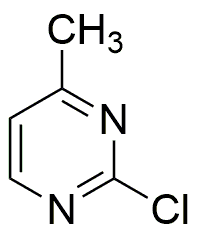2-Chloro-4-methylpyrimidine is widely utilized in research focused on:
- Pharmaceutical Development: This compound serves as a key intermediate in the synthesis of various pharmaceuticals, particularly in the development of antiviral and anticancer agents.
- Agricultural Chemicals: It is used in the formulation of herbicides and pesticides, helping to enhance crop protection and yield by targeting specific weed species.
- Material Science: The compound is employed in the creation of specialty polymers and resins, which are essential in manufacturing durable and high-performance materials.
- Research Reagents: As a versatile reagent, it is used in organic synthesis and analytical chemistry, facilitating the study of complex chemical reactions and mechanisms.
- Biochemical Applications: It plays a role in the design of enzyme inhibitors and other bioactive compounds, contributing to advancements in biochemistry and molecular biology.
General Information
Properties
Safety and Regulations
Applications
2-Chloro-4-methylpyrimidine is widely utilized in research focused on:
- Pharmaceutical Development: This compound serves as a key intermediate in the synthesis of various pharmaceuticals, particularly in the development of antiviral and anticancer agents.
- Agricultural Chemicals: It is used in the formulation of herbicides and pesticides, helping to enhance crop protection and yield by targeting specific weed species.
- Material Science: The compound is employed in the creation of specialty polymers and resins, which are essential in manufacturing durable and high-performance materials.
- Research Reagents: As a versatile reagent, it is used in organic synthesis and analytical chemistry, facilitating the study of complex chemical reactions and mechanisms.
- Biochemical Applications: It plays a role in the design of enzyme inhibitors and other bioactive compounds, contributing to advancements in biochemistry and molecular biology.
Documents
Safety Data Sheets (SDS)
The SDS provides comprehensive safety information on handling, storage, and disposal of the product.
Product Specification (PS)
The PS provides a comprehensive breakdown of the product’s properties, including chemical composition, physical state, purity, and storage requirements. It also details acceptable quality ranges and the product's intended applications.
Certificates of Analysis (COA)
Search for Certificates of Analysis (COA) by entering the products Lot Number. Lot and Batch Numbers can be found on a product’s label following the words ‘Lot’ or ‘Batch’.
*Catalog Number
*Lot Number
Certificates Of Origin (COO)
This COO confirms the country where the product was manufactured, and also details the materials and components used in it and whether it is derived from natural, synthetic, or other specific sources. This certificate may be required for customs, trade, and regulatory compliance.
*Catalog Number
*Lot Number
Safety Data Sheets (SDS)
The SDS provides comprehensive safety information on handling, storage, and disposal of the product.
DownloadProduct Specification (PS)
The PS provides a comprehensive breakdown of the product’s properties, including chemical composition, physical state, purity, and storage requirements. It also details acceptable quality ranges and the product's intended applications.
DownloadCertificates of Analysis (COA)
Search for Certificates of Analysis (COA) by entering the products Lot Number. Lot and Batch Numbers can be found on a product’s label following the words ‘Lot’ or ‘Batch’.
*Catalog Number
*Lot Number
Certificates Of Origin (COO)
This COO confirms the country where the product was manufactured, and also details the materials and components used in it and whether it is derived from natural, synthetic, or other specific sources. This certificate may be required for customs, trade, and regulatory compliance.


